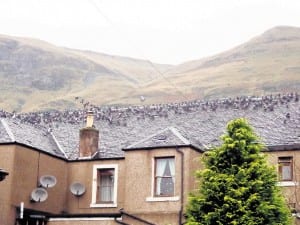
by Pigeon Patrol | May 6, 2016 | 4-S Gel Bird repellent, Animal Deterrent Products, Bird Deterrent Products, Bird Netting
 CASTLEHILL Church has been made secure ahead of a major clean-up inside.
CASTLEHILL Church has been made secure ahead of a major clean-up inside.
The privately owned building has become a roosting place for hundreds of pigeons, who have been able to access the building via slats in the roof and gaps in the stained glass windows.
Following pressure from the public and Moray Council during the summer, owner Claire Love has employed John Still Steeplejacks of Aberdeen to carry out the task.
Neighbouring manse owner, Kay Ferrett’s family suffered more than most from an infestation of flies plaguing the west end of Forres High Street, believed to be coming from numerous bird carcasses and droppings inside the church.
“Work has started on pigeon removal and clean up,” confirmed Ms Love in a brief email to the ‘Gazette’.
Mrs Ferrett was able to see the size of the task for herself when she went inside with the contractors.
“It’s nuts,” she said. “I never thought it would be this bad!
“They gave me a surgical mask to wear and I was escorted inside via the basement entrance.
“What I saw was horrendous – I was shocked by the mess and overcome by the smell, even through the mask. There was so much excrement and dead pigeons everywhere.
“It’s absolutely covered in poo and pigeons so I’m not surprised there were so many flies in my house over the summer.”
John Still Steeplejacks, roofers, slaters and joiners, also deal with bird and pest control.
“Our job is to clear the church of wildlife then clean up any mess they’ve made,” said Mr Still.
“We have no specific time frame but we want to get it done as quickly as possible as we have other commitments to keep.”
Homes and businesses near the church endured an invasion of flies during the summer, many believe were a result of what was inside.
Having seen them for herself, Mrs Ferrett hopes the clean-up will stop a repeat.
“Once we got upstairs, apart from what was underfoot, I was overcome by the beauty of the hall. It’s such a shame that it has been allowed to get into the state it’s in now.
“I was upset to hear that the church owner did not stick to the time lines for the clean-up set by the local authority during the last few months
“Thankfully they’re dealing with it now but I’m told it will take a few months to clean up.”
Moray Council will not be taking any enforcement action.
“The owner appears to be complying with what was requested of her in terms of boarding up the windows etc to prevent birds getting in and cleaning up the mess,” said a spokesman. “Assuming the owner is doing everything that was asked of her, we will not be taking any action.”
Meanwhile, a collapsing wall on the west wing continues to pose a problem for the community. Youths previously accessed the building at that side before it was secured.
Mr Still warned that it continues to be an issue: “A lower flat roof inside on the west wing is dangerous,” he said. “Particularly if anyone was to stand on it.
“We plan to put warning signs up to warn folk.”
About Pigeon Patrol:
Pigeon Patrol Products & Services is the leading manufacturer and distributor of bird deterrent (control) products in Canada. Pigeon Patrol products have solved pest bird problems in industrial, commercial, and residential settings since 2000, by using safe and humane bird deterrents with only bird and animal friendly solutions. At Pigeon Patrol, we manufacture and offer a variety of bird deterrents, ranging from Ultra-flex Bird Spikes with UV protection, Bird Netting, 4-S Gel and the best Ultrasonic and audible sound devices on the market today.
Voted Best Canadian wholesaler for Bird Deterrent products four years in a row.
Contact Info: 1- 877– 4– NO-BIRD (www.pigeonpatrol.ca)
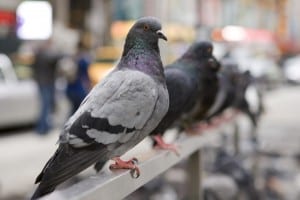
by Pigeon Patrol | May 3, 2016 | 4-S Gel Bird repellent, Bird Deterrent Products, Bird Netting, Pigeon Spikes
 Long-term pigeon solution
Long-term pigeon solution
There is no denying that feral pigeons are a huge problem in some areas and cause extensive soiling of property. Contrary to popular belief they do not pose a risk to public health. If you doubt this statement you are welcome to look up scientific articles online. It is only pest control companies that depict pigeons as a health hazard.
The fact remains that large populations of feral pigeons are a nuisance and need to be controlled, but culling is not the way to do it. Culling is a completely ineffective method for the control of pigeon populations. A sudden reduction in numbers simply creates an increase in the resources available to the remaining birds.
A population is sustained by the resources that surround it. As long as there is enough food to sustain them, the population will keep replenishing.
Pigeons are also prolific breeders and dedicated parents can hatch several clutches back to back. A single a pair of pigeons can churn out two self-sustaining fledglings roughly every 40 days.
How long would it take for the remaining population to reproduce the amount of birds culled? The reality is that it would only take a couple of months at most.
Even if the shooters managed to kill a whopping half of the population and even if we assume that half of the babies born were to die before leaving the nest, it would still take less than three months for the remaining pigeons to reproduce the culled half of their flock, thereby making the entire exercise useless.
Our local councils can either keep using very short-term and short-sighted methods that do not achieve any tangible results, or they can start being proactive
Contraceptives, though certainly more effective than culling, are not an ideal solution either. They are expensive, and to be effective you need to feed the correct dosage regularly over a long period of time. Can one reliably control or even know how much of the medication the pigeons are consuming?
Also, as I understand it, there is the inherent risk that other wild bird populations can also consume the contraceptive. This may or may not be a concern in Sliema but I do not believe that contraceptives are the best solution to nuisance pigeon populations.
Instead of looking only at available options, let us look at some success stories.
Take for example Nottingham City Hospital that in five years managed to reduce a flock of birds to just 63, an incredible 95% drop in the population. Surrey Heath Borough Council also achieved an 80% reduction in their pigeon population in five years.
Heath Park Hospital in Cardiff says it prevented the birth of 150 pigeons each month with the help of one single volunteer. Paris claims to have prevented over 5,000 pigeon births in one year. How did they do it?
They built a pigeon loft, encouraged the pigeons to sleep and breed there, and tossed out the eggs they laid. The majority of the soiling and damage is done when the pigeons are roosting at night.
By building a safe and welcoming environment for the pigeons to roost in, while also installing anti-roosting systems on buildings, the birds can be drawn away from the problem areas and into a controlled environment.
Furthermore these lofts allow for access to the single most effective method of population control there is: egg removal. By encouraging the birds to breed in a controlled environment the city can effectively gain control over the breeding of its resident pigeon population.
All one has to do is manage the loft properly, weekly replace any laid eggs with fake eggs, and regularly clean out the area to avoid insect infestations. This method of control was established with success by the Pigeon Control Advisory Service (PiCAS International http://www.pigeoncontrolresourcecentre.org/html/reviews/artificial-breeding-facilities.html) as far back as the 1970s.
Unlike culling, it is not only extremely effective when done properly, but is a cost-effective long-term solution. Lofts can be built cheaply, though Paris chose to invest a huge amount in installing state-of-the-art lofts in its parks. Lofts can really be made from pretty much anything, utilising unused spaces and recycled materials, as long as they meet the pigeons’ needs.
At the end of the day the goal is to reduce the negative impact pigeons have on their urban environment. Our local councils can either keep using very short-term and short-sighted methods that do not achieve any tangible results, or they can start being proactive and figure out where and how to implement a long-term solution that allows the births in the population to be controlled, that encourages the birds to roost away from buildings, and invest in educating the public to better control refuse and litter and limit the available food source.
One can start by looking at the online resources and advice available, for example from the PiCAS International website itself which last I checked offered free guidance to public institutions on how to install and manage a pigeon control loft correctly.
Furthermore why not involve the community in the project? Perhaps entice University students to use the project as part of their studies, whether from a design aspect, a management aspect, an agricultural and animal husbandry aspect, or even in the use of recycled materials. There is so much potential in such a project above and beyond reducing pigeon numbers.
This method of pigeon control is a long-term project for a long-term solution. As with any long-term project, it will only work if the council sticks to it and keeps up with the management, cleaning and egg removal. It is not a one-time solution that will fix everything overnight, but it is the only method that will successfully control the pigeon population and reliably and effectively reduce pigeon numbers in our towns and cities.
About Pigeon Patrol:
Pigeon Patrol Products & Services is the leading manufacturer and distributor of bird deterrent (control) products in Canada. Pigeon Patrol products have solved pest bird problems in industrial, commercial, and residential settings since 2000, by using safe and humane bird deterrents with only bird and animal friendly solutions. At Pigeon Patrol, we manufacture and offer a variety of bird deterrents, ranging from Ultra-flex Bird Spikes with UV protection, Bird Netting, 4-S Gel and the best Ultrasonic and audible sound devices on the market today.
Voted Best Canadian wholesaler for Bird Deterrent products four years in a row.
Contact Info: 1- 877– 4– NO-BIRD (www.pigeonpatrol.ca)
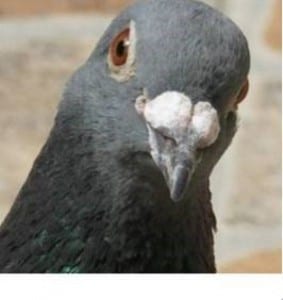
by Pigeon Patrol | May 2, 2016 | 4-S Gel Bird repellent, Bird Deterrent Products, Bird Netting, Pigeon Spikes
 They undertake some of the most audacious journeys in the animal kingdom, navigating across thousands of miles to arrive at a precise location.
They undertake some of the most audacious journeys in the animal kingdom, navigating across thousands of miles to arrive at a precise location.
Now scientists have unravelled exactly how migrating birds, butterflies and other animals are able to use the Earth’s magnetic field to help them find their way.
They have discovered proteins that ‘act like a compass’ are produced in the retina and nerve cells running from the eye to the brain.
Pigeons are known for their navigational ability but now scientists claim to have discovered the molecules the birds use to find their way. The animals, along with many other species, have proteins that form a rod-shaped complex that orientate themselves in a north to south direction in the Earth’s magnetic field
These molecules form a rod-like complex with light sensitive proteins and orientate themselves in a north to south direction in a magnetic field.
Together, this complex allows the animals to sense the direction they are travelling by combining information about the Earth’s magnetic field and the position of the sun.
RUSSIANS USE MAGNETS TO THROW MIGRATING BIRDS OFF COURSE
Long-distance songbirds perform incredible feats of navigation during their spring migration.
While scientists know the birds use the sun or stars as a ‘map,’ the idea that birds use magnetic compasses has been difficult to prove.
Now a group of researchers have used a magnet to deliberately send Eurasian reed warblers off course, to show they rely on a geomagnetic map cues to point them in the right direction.
In the experiment, the birds were captured at Rybachy, Russia, during their spring migration.
To test the role of magnetic fields, Dmitry Kishkinev of Queen’s University Belfast and Nikita Chernetsov at the Biological Station Rybachy housed caught birds outdoors in wooden and cloth cages so they had a clear view of the sky and their surroundings.
They observed the birds naturally orientated north-east, which matches the chosen direction of migration recorded over the previous decade.
They then generated a magnetic field identical to that found in the town of Zvenigorod near Moscow.
The system allowed them to manipulate the magnetic field without obscuring the birds’ ability to pick up on other cues, including the sun, stars, landmarks, and scents, which are also thought to help birds find their way across vast distances.
During the several days that the birds were housed in the magnetic coil system, they were led to ‘think’ they were in Zvenigorod, some 621 miles (1,000km) away.
Perhaps most astonishingly, the researchers discovered that humans also express these same proteins, albeit in far smaller amounts, raising the prospect that we too have some ability to sense the magnetic field.
Dr Can Xie, a molecular biologist at Peking University in China who led the research, said the proteins appear to act just like a compass needle and send information to the nervous system.
Writing in the journal Nature Materials, Dr Xie and his colleagues said: ‘The notion that animals can detect the Earth’s magnetic field was once ridiculed, but is now well established.
‘The biocompass model we present here may serve as a step towards fully uncovering the molecular mechanism of animal navigation and magnetoreception.
‘The existence of a human magnetic sense remains controversial but geomagnetic fields are thought to affect the light sensitivity of the human visual system.’
Many animals are thought to use the Earth’s magnetic fields to help them navigate including sharks, sea turtles, birds, insects, wolves, whales and even worms.
However, exactly how they do this has remained a mystery.
Some researchers previously identified specific cells in the eyes and beaks of birds like pigeons that seem to respond to a magnetic field.
The exact source was unknown, and some researchers identified clumps of iron bound by molecules as being responsible, while others attributed it to light-sensitive proteins called cyrptochromes.
The research by Dr Xie and his team, however, has found that these two systems in fact work together to form a navigational complex inside the cells of these animals.
In particular, they discovered a gene called MagR that produces a protein that combines with cryptochrome to form a cylinder shaped complex.
Ten cryptochrome molecules encase 20 MagR proteins to form this rod that then aligns itself with a magnetic field.
They were so magnetic that the researchers had to develop special plastic tools to conduct their research
Insects, including monarch butterflies (pictured) were also found to produce the proteins to help them navigate. Monarch butterflies undertake one of the greatest migrations on the planet, travelling up to 3,100 miles
The scientist found these molecules are particularly highly expressed in the retinal neurons running from the eye to the brain.
Fruit flies, monarch butterflies, pigeons and humans all produce these molecules while other creatures including minke whales and naked mole rats also have these magnetic proteins.
The researchers say their findings may also now lead to a new area of research that could have numerous biological and industrial applications.
It could lead to new types of genetic treatments that respond to magnetic fields or ways of increasing magnetic sensitivity.
The MagR proteins form a magnetic core inside a coat of light sensitive cryptochrome molecules (Crys) to form a cylinder. The graphic above shows how they orientate in the complex on the left while the diagram on the right shows the cylinder of proteins in a cross section
The MagR proteins form a magnetic core inside a coat of light sensitive cryptochrome molecules (Crys) to form a cylinder. The graphic above shows how they orientate in the complex on the left while the diagram on the right shows the cylinder of proteins in a cross section
They said: ‘It has not escaped our notice that the magnetic features of the MagR polymer and Cry/MagR complex may provide a useful tool for the isolation and manipulation of macromolecules with external magnetic fields, give rise to magnetogenetics and inspire numerous potential applications across different fields.’
Dr Steven Reppert, a neurobiologist at the University of Massachusetts who was not involved in the research, told New Scientist that the research could have huge implications.
He said: ‘It’s provocative and potentially ground breaking. It took my breath away.’
About Pigeon Patrol:
Pigeon Patrol Products & Services is the leading manufacturer and distributor of bird deterrent (control) products in Canada. Pigeon Patrol products have solved pest bird problems in industrial, commercial, and residential settings since 2000, by using safe and humane bird deterrents with only bird and animal friendly solutions. At Pigeon Patrol, we manufacture and offer a variety of bird deterrents, ranging from Ultra-flex Bird Spikes with UV protection, Bird Netting, 4-S Gel and the best Ultrasonic and audible sound devices on the market today.
Voted Best Canadian wholesaler for Bird Deterrent products four years in a row.
Contact Info: 1- 877– 4– NO-BIRD (www.pigeonpatrol.ca)
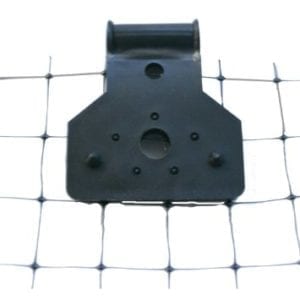
by Pigeon Patrol | May 1, 2016 | 4-S Gel Bird repellent, Bird Deterrent Products, Bird Netting, Pigeon Spikes
 SDLP Councillor Martin Reilly has called for improvements on the Craigavon Bridge in Derry to address the problem of “unpleasant and unsafe” pigeon deposits which, he claims, are causing distress to cyclists and pedestrians.
SDLP Councillor Martin Reilly has called for improvements on the Craigavon Bridge in Derry to address the problem of “unpleasant and unsafe” pigeon deposits which, he claims, are causing distress to cyclists and pedestrians.
Cllr Reilly was speaking after he was contacted by members of the public who use the cycle path along the lower deck of the bridge (pictured) who, he said, were “annoyed” at the gathering of pigeon mess which made cycling and walking “unpleasant and unsafe.”
Cllr Reilly: “Unfortunately, this part of the bridge is too narrow for Council cleansing vehicles – and in the past Council worked with Transport NI and Sustrans to close this stretch to carry out the necessary cleaning works.
“While this cleaning work is welcome the effects do not last long and a more permanent solution is required.
“Transport NI previously suggested installing netting in this area to prevent pigeons from roosting.”
Cllr Reilly concluded: “I am therefore calling on these statutory agencies to work together to find an adequate solution which would encourage further use of this key walkway and cycle route.”
About Pigeon Patrol:
Pigeon Patrol Products & Services is the leading manufacturer and distributor of bird deterrent (control) products in Canada. Pigeon Patrol products have solved pest bird problems in industrial, commercial, and residential settings since 2000, by using safe and humane bird deterrents with only bird and animal friendly solutions. At Pigeon Patrol, we manufacture and offer a variety of bird deterrents, ranging from Ultra-flex Bird Spikes with UV protection, Bird Netting, 4-S Gel and the best Ultrasonic and audible sound devices on the market today.
Voted Best Canadian wholesaler for Bird Deterrent products four years in a row.
Contact Info: 1- 877– 4– NO-BIRD (www.pigeonpatrol.ca)
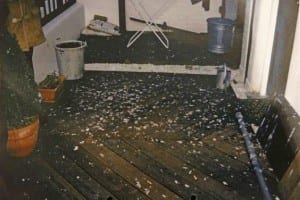
by Pigeon Patrol | Apr 29, 2016 | Bird Deterrent Products, Bird Netting, Pigeon Patrol's Services, UltraSonic Bird Control
 A FORMER mayor of Derry has called for action over pigeon poop along one of the city’s main thoroughfares.
A FORMER mayor of Derry has called for action over pigeon poop along one of the city’s main thoroughfares.
Martin Reilly has said measures need to be taken to stop pigeons dropping their “unpleasant and unsafe” deposits on unsuspecting pedestrians and cyclists using the city’s Craigavon Bridge.
A common problem in all urban areas, pigeon droppings are unsightly and can cause disease. Local authorities spend large sums of money in their attempts to control pigeon numbers. However, as the birds breed all year round, efforts are often ineffective.
Problems caused by pigeons often attract huge interest. Rufus, an American Harris Hawk, is widely known for his exploits in killing the birds over the All England Tennis Club before and during the annual Wimbledon tournament.
In other areas, other forms of culls are carried out while many authorities cover buildings with specialised anti-bird netting to prevent the pigeons from roosting and breeding.
Mr Reilly, a former SDLP mayor, said he has been contacted by people using the cycle path along the lower deck of Craigavon Bridge who are annoyed at the mess made by the birds. He said the problem had become so bad that walking and cycling along the path was unsafe.
Mr Reilly said Transport NI had suggested using netting to prevent pigeons from roosting on the bridge. He said there could also be other ways of deterring the birds such as by using particular paints to prevent them from nesting.
“I am therefore calling on these statutory agencies to work together to find an adequate solution which would encourage further use of this key walkway and cycle route,” he said.
About Pigeon Patrol:
Pigeon Patrol Products & Services is the leading manufacturer and distributor of bird deterrent (control) products in Canada. Pigeon Patrol products have solved pest bird problems in industrial, commercial, and residential settings since 2000, by using safe and humane bird deterrents with only bird and animal friendly solutions. At Pigeon Patrol, we manufacture and offer a variety of bird deterrents, ranging from Ultra-flex Bird Spikes with UV protection, Bird Netting, 4-S Gel and the best Ultrasonic and audible sound devices on the market today.
Voted Best Canadian wholesaler for Bird Deterrent products four years in a row.
Contact Info: 1- 877– 4– NO-BIRD (www.pigeonpatrol.ca)
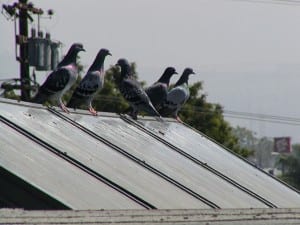
by Pigeon Patrol | Apr 28, 2016 | Bird Deterrent Products, Bird Netting, UltraSonic Bird Control
 The city of New Baltimore recently celebrated the completion of three federally funded projects that aim to improve water quality in Lake St. Clair.
The city of New Baltimore recently celebrated the completion of three federally funded projects that aim to improve water quality in Lake St. Clair.
Walter and Mary Burke Park now boasts three new rain gardens, two electronic bird deterrents and permeable pavers, which all work to improve the quality of the stormwater runoff that enters Lake St. Clair. A ribbon-cutting ceremony took place at the park on Oct. 21 to mark the completion of the project.
“These rain gardens and the pervious pavers above them will help improve the water quality at our beach and all of Lake St. Clair,” Mayor John Dupray said. “It will do this by reducing the pollutants that drain directly into the lake and improving soil erosion and stormwater runoff.”
Two of the new rain gardens are located near the lake front by the outdoor pavilion, and the third garden is located near the swing sets.
Rain gardens are created by digging out an area and filling it with materials that allow water to run down into the ground, such as native plants with long root systems that help infiltrate water deep into the soil. This allows the ground to absorb water slowly, rather than running into the lake without treatment.
The gardens are part of a solution to occasional beach closures at Burke Park, according to the city. Stormwater runoff is a key mechanism for contaminants to reach the beach and is considered one of the biggest sources of water pollution, according to Environmental Consulting and Technology Inc., the project engineer for the improvements.
ECT determined that stormwater runoff is a probable source of E. coli. Geese and seagull droppings also contaminate the runoff, which then makes its way to the beach.
To deter geese and seagulls from the beach area, electronic audial devices have been installed on each end of the outdoor pavilion in Walter and Mary Burke Park. The devices emit bird distress cries to discourage birds from landing in the area, including the boat docks.
“The bird deterrent devices should reduce the mess the gulls and Canada geese cause and improve the health and concerns of our park visitors,” Dupray said.
New Baltimore Parks and Recreation Department Director Lee Miller said the city’s goose deterrent program was extremely successful this summer, significantly reducing the amount of goose droppings in the park. Continued…“As a result of that, we only had to close the public beach once the entire summer,” Miller said. “In years past, we would have to close the beach on an average three to four times, but this year, our lake water was extremely clean.”
In addition, the newly installed permeable brick pavers at the entrance to the park also work to improve water quality by allowing water to enter the soil while still providing a solid and stable walking surface. The former impervious surfaces at the entrance to the park did not absorb water, potentially allowing runoff water to carry pollutants directly into the lake.
“I think the three projects that were completed in the park have turned out very well,” Miller said. “The brick pavers at the main park entrance look great, and we are very excited to see the rain gardens grow and bloom into beautiful landscaping.”
Miller said he thinks the city’s efforts will not only benefit the nearly 1,000 people who visit the beach each weekend during the summer, but also the environment and the wildlife that lives in it.
“Lake St. Clair has an extremely vibrant eco-system with a wide variety of fish populations,” he said, “and we believe that our efforts will play a part in keeping Anchor Bay environmentally healthy.”
The projects were completed with a roughly $260,000 grant obtained through the U.S. Environmental Protection Agency’s Great Lakes Restoration Initiative. The work was overseen by the Macomb County Office of Public Works and was completed by Tom Ward & Sons Inc. of Casco Township, Dupray said.
“I am very pleased with the quality of the work and the end results,” he said. “We were certainly fortunate to receive this federal grant and to have Macomb County Public Works Department oversee the construction, all at no cost to our residents.”
Construction took about a month and a half to complete. The popular dahlia garden is expected to return to the park next spring.
“The Koenig family has been patient through the construction and will be back with the city’s adopted flower for all to enjoy,” Dupray said.
The amount of park space was also temporarily reduced during construction due to fencing placed around the gardens. The parks and rec department worked to alleviate inconvenience by offering “construction refunds” to pavilion renters as well as an opportunity to cancel with a full refund, Miller said. Continued…“There were many pieces to the puzzle for this project, and with that being considered, I think everything went very well,” he said.
About Pigeon Patrol:
Pigeon Patrol Products & Services is the leading manufacturer and distributor of bird deterrent (control) products in Canada. Pigeon Patrol products have solved pest bird problems in industrial, commercial, and residential settings since 2000, by using safe and humane bird deterrents with only bird and animal friendly solutions. At Pigeon Patrol, we manufacture and offer a variety of bird deterrents, ranging from Ultra-flex Bird Spikes with UV protection, Bird Netting, 4-S Gel and the best Ultrasonic and audible sound devices on the market today.
Voted Best Canadian wholesaler for Bird Deterrent products four years in a row.
Contact Info: 1- 877– 4– NO-BIRD (www.pigeonpatrol.ca)

 CASTLEHILL Church has been made secure ahead of a major clean-up inside.
CASTLEHILL Church has been made secure ahead of a major clean-up inside.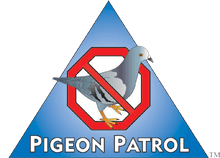

 Long-term pigeon solution
Long-term pigeon solution
 They undertake some of the most audacious journeys in the animal kingdom, navigating across thousands of miles to arrive at a precise location.
They undertake some of the most audacious journeys in the animal kingdom, navigating across thousands of miles to arrive at a precise location.
 SDLP Councillor Martin Reilly has called for improvements on the Craigavon Bridge in Derry to address the problem of “unpleasant and unsafe” pigeon deposits which, he claims, are causing distress to cyclists and pedestrians.
SDLP Councillor Martin Reilly has called for improvements on the Craigavon Bridge in Derry to address the problem of “unpleasant and unsafe” pigeon deposits which, he claims, are causing distress to cyclists and pedestrians.
 A FORMER mayor of Derry has called for action over pigeon poop along one of the city’s main thoroughfares.
A FORMER mayor of Derry has called for action over pigeon poop along one of the city’s main thoroughfares.
 The city of New Baltimore recently celebrated the completion of three federally funded projects that aim to improve water quality in Lake St. Clair.
The city of New Baltimore recently celebrated the completion of three federally funded projects that aim to improve water quality in Lake St. Clair.